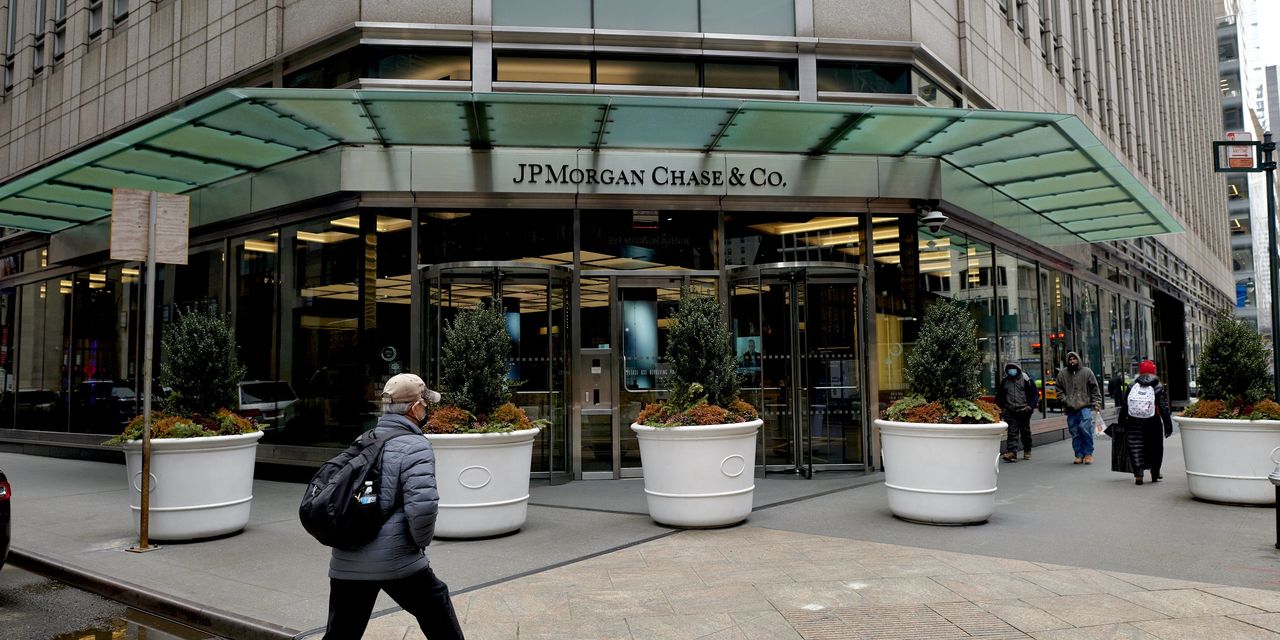
Rising interest rates are going to be good for banks. Someday.
JPMorgan Chase JPM -6.15% reported record annual profit in 2021 on Friday. But a combination of that being driven in part by releases of set-asides for bad loans, plus uncertainty about 2022, will have many investors immediately looking past that remarkable result. For now that is putting some big pressure on the stock, which fell sharply Friday morning. Investors shouldn’t lose sight of the bigger picture.
On the face of it, the likelihood of a series of Federal Reserve rate increases should be a solid foundation for big banks, driving lending income higher. There also ought to be a strong tailwind from the U.S. economic growth anticipated for this year, and from consumers and businesses being relatively flush and unlikely to produce waves of defaults.
But JPMorgan also detailed a number of challenges that might offset these positives in the year ahead. At least in 2022, this could make it tough to hit the bank’s medium-term target of a 17% return on tangible common equity.
For one, consumers still aren’t revolving balances on their cards as much as they have historically. The profit upshot of higher rates can in effect be muted by less borrowing. JPMorgan said that, although spending volume was above pre-pandemic levels, outstanding card balances in the fourth quarter were 8% below the same period in 2019. Growth has picked up since the middle of 2021; but, roughly speaking, the bank still isn’t expecting revolving balances on cards to return to pre-pandemic levels until around the end of this year.
Then there is the other side of the higher-rates coin: Inflation. Inflationary pressures on expenses—across compensation, travel-and-entertainment spending and other areas—could snip about 0.75 percentage points off returns on tangible common equity in 2022, the bank outlined. Over time, the hope is that higher rates would outweigh the effect of higher costs—if those rises are modest.
None of this is to say that higher rates aren’t still fundamentally good for banks, especially if the curve is steep. JPMorgan is continuing to hedge its bets on rates, saying it has been cautious about buying longer-duration assets when it adds to its securities portfolio, which would lock in current rates. Chief Executive Jamie Dimon believes there is a good chance the Fed might act more aggressively on rates than markets anticipate. This gives the bank a huge opportunity to deploy its massive liquidity when rates are higher.
Plus, a volatile rate environment could help Wall Street revenues stay elevated for a while longer. Fixed-income trading desks in particular could be busy handling trades if the pace of rate increases contains surprises. Another strong year in markets and investment banking would bring a substantial benefit to returns.
So perhaps investors thinking about 2022 shouldn’t expect banks to react positively to every indicator of higher rates. But they also shouldn’t abandon them for the longer term.
Write to Telis Demos at [email protected]
Copyright ©2022 Dow Jones & Company, Inc. All Rights Reserved. 87990cbe856818d5eddac44c7b1cdeb8
Appeared in the January 15, 2022, print edition as ‘Bank Investors Must Wait for the Fed.’








